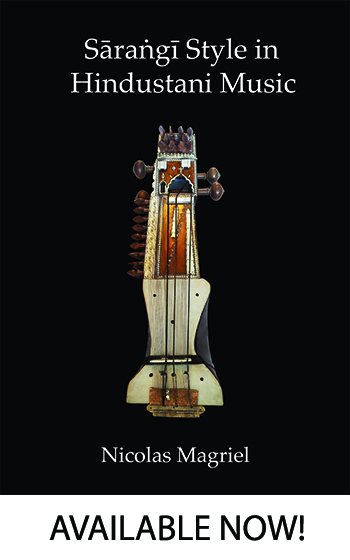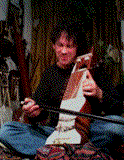This website is a redesigned and expanded version of "Nicolas Magriel's Sarangi Site" which I created rather idiosyncratically in 1997 during the internet's early days. The site became an archival treasure chest in 2014, and it has now been modernised and rebuilt in 2024. Sarangi.net is dedicated to the sarangi and the many sarangi players whom I have had the good fortune to know. On this site you can find:
1) a mammoth archive documenting over a hundred sarangi players whom I worked with when doing my PhD research in India in the nineties. This includes biographical and anecdotal information, but most importantly, videos and audio. As of March 25, 2015 there were 300 videos of 52 sarangi players on the site as well as some rare audio of great sarangiyas of the 20th century. As of October 2024, there are now more than 700 videos populating the site.
2) information about the sarangi, its history and social significance, its construction, maintenance and repair, and its technique.
3) information about my own musical journey as well as about my research on South Asian music. My articles and PowerPoint presentations and links to my other publications will appear in due course.
4) Information about my teaching of sarangi, vocal music and other instruments in London and online. The video archive includes videos of my own lessons with several masters of the instrument and videos of me teaching my own students in London and online.
The process of creating the archive
The editing, converting, uploading and embedding of video is a mammoth task. During the 90s I shot about 450 hours of Hi-8 video of over a hundred sarangi players in eighteen cities of North India. Regretfully I didn't make it to Pakistan at this time!
The individual analogue tapes, already digitised and saved on hard disks in 2008, have to be edited into individual rag performances, conversations and home-life vignettes which then need to be individually exported from Final Cut Pro, converted to a Vimeo-approriate codec, uploaded to Vimeo and finally embedded on the sarangi players' pages on this site and annotated. This is extremely time-consuming unpaid work and there's only me to do it. But my hope is that all of this unique footage will eventually make its way onto sarangi.net. As of October 2024, there are now approximately 700 sarangi videos displayed on the site. Of these, around 250 were edited, converted, uploaded and embedded since April 2024.
The historical and anecdotal information that I am writing about individual players combines what I can remember off the top of my head with historical notes and information contained in interviews on the recordings themselves. In many cases my interviews with sarangi players were on DAT (digital audio) tapes—not on the videos, and I have several hundred hours of DAT recordings from the 1990s, only summarily logged—it's a quagmire. So, for the time being, you will find that the most extensive personal information is to be found on the pages for those players who were also my own sarangi teachers.
The sarangi at home
People in India sometimes know the public face of sarangi—on the concert stage or how it is represented in Bollywood films. They know nothing about the life of sarangi players, about the gruelling practice sessions, about the intimate relationship sarangi players have with their instruments—repairing and maintaining them themselves. Because I am a sarangi player myself and have enormous sympathy with the plight of sarangi players, both musically and socially, when I was doing my fieldwork in the 1990s, I had unprecedented access to their homes. This video archive comes a long way towards illuminating the real world of sarangi players and sarangi life.
This website also pays tribute to the world of tawayafs, the courtesans whom sarangi players traditionally accompanied, the singing and dancing women who in the words of my dear ustad Abdul Latif Khan "kept this music alive for the last four hundred years". These women have been excised from the history of Indian classical music as part of the crusade to make the music respectable and suitable for middle class consumption—a crusade which began to take shape in the latter half of the nineteenth century in tandem with aspirations for Indian independence and statehood.
I am happy to be able to share videos of mujhras, courtesan performances in Banaras, Mirzapur and Calcutta.
What is Sangi Rangi?
The name Sangi Rangi has a history. I keep the rosin for my bow melted into a short half section of bamboo about five centemeters wide and twelve long. One day it was broken, and I went looking for a new piece of bamboo in Banaras. The places that sold it would only sell entire poles three or four metres long. I was told to go to the burning ghats and there I would find what I needed easily. I went to Harish Chandra Ghat and sheepishly asked one of the workers there if he could give me some bamboo (used for stretchers to carry the bodies and lay them on their funeral pyres). He asked what I wanted it for—and another worker there answered for me "sangi rangi ke liye" (for a sarangi or something). Evidently I was not the first sarangi wala to come looking there for bamboo.
Acknowledgements
I want to voice eternal gratitude to all my teachers and to the many sarangi players who populate this sight—most of whom I worked with and filmed in the 1990s. I am grateful to Evangelos Himonides who first steered me towards the Joomla content management system and has helped me wriggle out of many a technical tangle over the years. Justin Litten has helped immensely with trecherous hiccups that arose in the course of sarangi.net's modernisation in 2024. In the summer of 2024, SEMPRE (Society for Education, Music and Psychology Research made a generous contribution towards my further developing this archive. Thank you!



